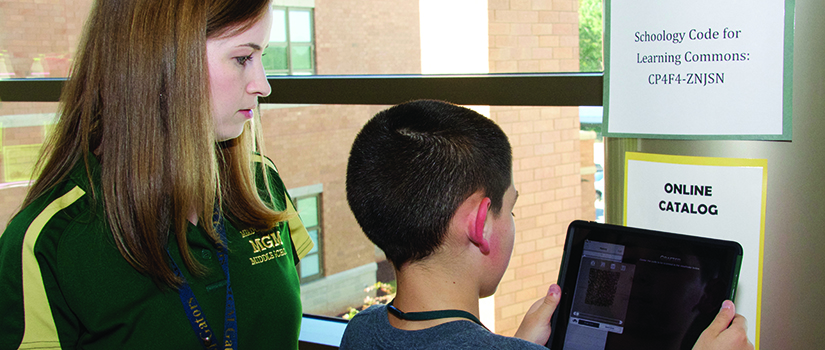Posted June 2, 2015
Reprinted from InterCom (pdf)
Story and photos by Emily Olyarchuk, senior public relations major
Photo: Alumna Jessica Kohout works with a student at Meadow Glen Middle School to
integrate new technology in the library setting.
“When the Internet came along, this library school was waiting for it,” said Jack Bryan, School of Library and Information Science alumnus and retired director of administration for the S.C. Attorney General. “Technology is always something to be embraced, not just to organize the past, but to bring us into the future.”
In 1979, when the University of South Carolina established what is now the School of Library and Information Science, the image of the librarian as a library caretaker was transformed. The school embraced technological advances by employing innovative professors and offering instruction in special libraries before the Internet was a public service.
“My first experience with computers was at Florida State University,” said Dr. Bob Williams, SLIS distinguished professor emeritus. “We used to go to the computer center and look into the window and look at the lights that were blinking.”
Before online databases, people waited up to two years before receiving usable and updated indexes from publishers. In 1978, students could be seen crowding around electronic typewriters to study their professors’ research and data collecting techniques. It was a time of punch cards and patience.
In 1990, Davis College received a computer terminal. The library and information science program was the first in the state to make the Internet accessible to faculty and students. SLIS faculty held workshops from the mid to late 90s at other South Carolina universities and local agencies to teach those staffs how to use computers.
In 1986, distance learning began with the help of the South Carolina Education Television (ETV) network. Lectures were recorded in a studio on USC’s campus and broadcast at several locations around the state. If you missed class there was no need to worry, the school could send you a VHS tape of the lecture. The program made it easier for students who did not have an accredited master’s program in their state—Maine and West Virginia especially--to earn a degree. Approximately 95 percent of distance learning students graduate from the SLIS program without ever stepping foot on USC’s campus.
SLIS is constantly searching for “What’s new, what’s out there, and where can it feasibly fit in our field of education, learning and technology?” said Dr. Heather Moorefield-Lang, a SLIS assistant professor and technophile. Robotics, circuitry, data analysis, coding and programming are already finding their way into libraries and school programs. The new age spawned e-librarians, meta data librarians and informatics librarians.
If it doesn't work we can try something else tomorrow. That is the spirit of innovation. Dr. Heather Moorefield-Lang
As new technologies provide libraries and librarians more options to conduct research and solve problems, library programs and learning spaces must adapt to remain effective and influential. One solution is maker’s spaces, interactive and innovative work areas for youths. No two maker’s spaces are the same. Some may be arts-based for crafting, drawing and painting, and others are STEAM based, an acronym for science, technology, engineering, art and math in a library setting.
“You’ve got a do–it-yourself area where students can come up with creative ideas or ways to solve a problem or solve from an angle they never thought of,” Dr. Moorefield-Lang said. She is currently pursuing opportunities for special training in maker’s spaces for library students at USC.
If you thought being able to search two keywords in 1980 was impressive, realize that today you can give a database your research question, say “go fetch,” and when information is available, you will receive texts to your phone. Researchers can sign up for Google Alerts and a variety of other database mechanics that make finding and using information faster and easier. But, the greatest difference between database researching 10 years ago and today is the accessibility of information and the mobility of access. Massive amounts of information are within reach wherever you go.
Over time, the SLIS program will constantly be challenged with new technology, how new elements can be used to benefit the program and a changing student population as incoming students will already possess an advanced technological aptitude and dependency. “It may work or it may not,” Dr. Moorefield-Lang said. “If it doesn’t work we can try something else tomorrow. That is the spirit of innovation."
